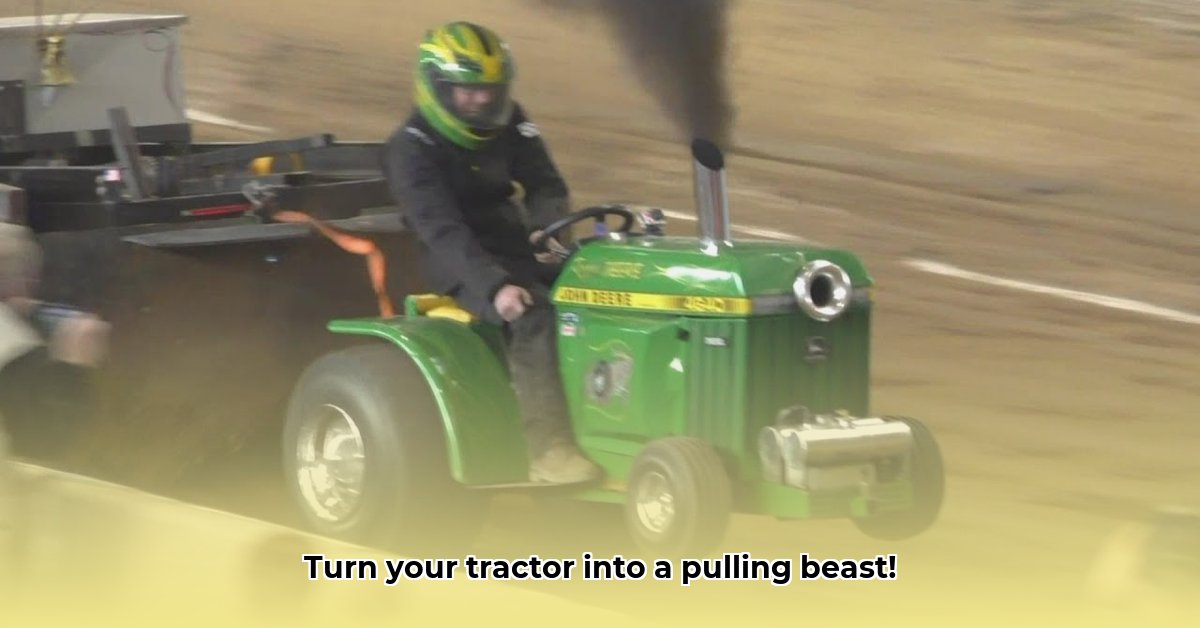
So, you're ready to transform your diesel garden tractor into a pulling champion? This comprehensive guide will walk you through the process, from selecting the right machine to making crucial modifications and ensuring your safety. Diesel tractor pulling offers a cost-effective and thrilling way to test your mechanical skills and compete against fellow enthusiasts. For more on tractor attachments, check out this helpful resource. Let's get started!
Choosing Your Pulling Machine
Selecting the right tractor is the cornerstone of success. Kubota Z-series tractors are frequently favored due to their robust engines, readily available parts, and proven reliability. However, other brands and models (depending on size and engine specifications) can also perform well.
The key is to find a used tractor in good working condition. This allows you to modify a strong base at a lower entry cost. Prioritize a healthy engine; meticulously inspect for leaks, wear, and any signs of neglect. Consider having a qualified mechanic evaluate the tractor before purchasing it. Are you ready to invest the time and effort required to transform your tractor?
Essential Modifications: Unleashing Your Tractor's Potential
These modifications are crucial for maximizing your tractor's pulling power and ensuring its durability under the stress of competition:
1. Engine Tuning and Upgrades
Optimizing your engine's performance is paramount. A professional tune-up can significantly enhance both horsepower and torque (the rotational force that drives pulling power), resulting in a noticeable improvement in pulling ability. It's like taking your car to a performance specialist—small adjustments yield big differences. Additionally, upgrading to a high-performance air filter improves airflow to the engine, facilitating more efficient fuel combustion and therefore more power. This is a relatively inexpensive modification with a significant impact.
2. Cooling System Optimization
Effective cooling is critical during intense pulling sessions. The engine works much harder than during typical garden tasks, and overheating is a major risk. Upgrading to an oil-cooled system (as opposed to a standard air-cooled system) is a worthwhile investment, despite the higher initial cost. Oil-cooling provides superior heat dissipation, minimizing the risk of engine damage and allowing for more prolonged, strenuous operation. How much more power will you gain with a cooler, more resilient engine?
3. Rear-End Configuration: Locked vs. Unlocked Differential
The differential controls how power is distributed to the rear wheels. A locked differential sends equal power to both wheels, providing maximum traction for pulling but reducing maneuverability. An unlocked differential allows for varied power distribution, enhancing turning but potentially sacrificing traction during a pull. The best choice depends on the specific competition rules and your driving preferences. What advantages does a locked differential offer in a straight-line pull?
4. Weight Management: Strategic Ballasting
Adding weight strategically improves traction and stability. Competition rules dictate weight limits, so careful planning is essential. Focus on distributing weight evenly to the rear of the tractor for optimal balance and pulling force. This may involve adding weights to the rear tires, filling tire cavities with ballast, or utilizing other approved weight-adding methods. How much weight can you add without compromising maneuverability or exceeding competition limits?
Advanced Modifications (For Experienced Mechanics Only!)
These modifications introduce significant complexity and risk. Only attempt these if you possess substantial mechanical experience and a thorough understanding of diesel engines:
Turbochargers: While turbochargers dramatically increase horsepower, they also place considerable stress on the engine. These require precise tuning and professional installation.
Fuel Injection Upgrades: Modifying the fuel injection system can yield power gains, but incorrect adjustments can severely damage your engine. Professional assistance is mandatory.
Safety: Your Top Priority
Modifying diesel engines is inherently risky. Always prioritize safety:
Wear appropriate personal protective equipment (PPE), including safety glasses, gloves, hearing protection, and sturdy work boots.
Work in a well-ventilated area to avoid inhaling harmful fumes.
Never attempt modifications beyond your skill level. Consult with an experienced mechanic if you’re unsure.
Have a fire extinguisher readily available.
Sourcing Parts and Fabrication: Finding the Right Components
M&D Mowers and other agricultural equipment suppliers are good starting points for sourcing parts. However, you may need to explore online marketplaces and local shops to find specific components. Basic fabrication skills may be required to adapt existing parts to your tractor.
Community and Resources: Leveraging Collective Knowledge
Online forums dedicated to tractor pulling are invaluable resources. Engage with other enthusiasts to share knowledge, get advice, and learn from their experiences.
Competition Rules and Regulations: Compliance is Key
Thoroughly research the specific rules of the competitions you plan to enter. Compliance ensures fair play and avoids disqualification.
Conclusion: Prepare for the Pull!
Modifying your diesel garden tractor for pulling is a rewarding and challenging undertaking. Remember to prioritize safety, leverage the knowledge of the community, and follow competition rules. Get ready for the thrill of the competition!